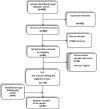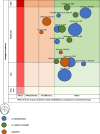Virtual reality in stroke recovery: a meta-review of systematic reviews
- PMID: 39367480
- PMCID: PMC11452980
- DOI: 10.1186/s42234-024-00150-9
Virtual reality in stroke recovery: a meta-review of systematic reviews
Abstract
Background: Virtual Reality (VR) is an emerging technology in post stroke recovery. However, its precise role in stroke rehabilitation is not well defined. The aim of this paper is to conduct an overview of systematic reviews on the role of VR in stroke rehabilitation.
Methods: A meta-review with results from a search of 7 databases from inception till 5th December 2022 with subsequent quality appraisal was conducted. The primary outcome was to produce a narrative review on the efficacy of VR versus usual or other care in stroke recovery. Data was synthesized in a descriptive fashion and high-quality systematic reviews were emphasized. The AMSTAR-2 tool was used for quality assessment of the included studies.
Results: Evidence from high-quality systematic reviews suggests that there is benefit from VR in upper limb, lower limb, gait, and balance recovery particularly when additive to conventional therapy. There is also limited evidence to suggest that VR has a positive effect in those with impaired cognition.
Conclusion: VR is safe and effective as an adjunct to conventional therapy for adults after stroke and should be used routinely for upper and lower limb motor recovery. Further high-quality studies that evaluate its efficacy and explore ways to increase its positive impact in areas such as cognition are required. There is also a scope for the development of stroke-specific virtual environments. (PROSPERO registration # CRD42022372926).
Keywords: Rehabilitation; Stroke recovery; Systematic reviews; Virtual reality.
© 2024. The Author(s).
Conflict of interest statement
The authors declare that they have no competing interests.
Figures
Similar articles
-
Effectiveness and safety of virtual reality rehabilitation after stroke: an overview of systematic reviews.EClinicalMedicine. 2023 Sep 14;64:102220. doi: 10.1016/j.eclinm.2023.102220. eCollection 2023 Oct. EClinicalMedicine. 2023. PMID: 37745019 Free PMC article.
-
The effectiveness of virtual reality for rehabilitation of Parkinson disease: an overview of systematic reviews with meta-analyses.Syst Rev. 2022 Mar 19;11(1):50. doi: 10.1186/s13643-022-01924-5. Syst Rev. 2022. PMID: 35305686 Free PMC article. Review.
-
Examining the effect of virtual reality therapy on cognition post-stroke: a systematic review and meta-analysis.Disabil Rehabil Assist Technol. 2022 Jan;17(1):50-60. doi: 10.1080/17483107.2020.1755376. Epub 2020 May 2. Disabil Rehabil Assist Technol. 2022. PMID: 32363955
-
Clinical Application of Virtual Reality for Upper Limb Motor Rehabilitation in Stroke: Review of Technologies and Clinical Evidence.J Clin Med. 2020 Oct 21;9(10):3369. doi: 10.3390/jcm9103369. J Clin Med. 2020. PMID: 33096678 Free PMC article. Review.
-
Application of Virtual Reality-Assisted Exergaming on the Rehabilitation of Children with Cerebral Palsy: A Systematic Review and Meta-Analysis.J Clin Med. 2023 Nov 14;12(22):7091. doi: 10.3390/jcm12227091. J Clin Med. 2023. PMID: 38002703 Free PMC article. Review.
Cited by
-
Efficacy of Body Representation Rehabilitation Training for Adults with Unilateral Brain Damage: A Preliminary Study.Brain Sci. 2025 Jan 30;15(2):140. doi: 10.3390/brainsci15020140. Brain Sci. 2025. PMID: 40002473 Free PMC article.
-
Effect of virtual reality-based upper limb training on activity of daily living and quality of life among stroke survivors: a systematic review and meta-analysis.J Neuroeng Rehabil. 2025 Apr 24;22(1):92. doi: 10.1186/s12984-025-01603-1. J Neuroeng Rehabil. 2025. PMID: 40269877 Free PMC article.
-
The effectiveness of theta burst stimulation for motor recovery after stroke: a systematic review.Eur J Med Res. 2024 Nov 29;29(1):568. doi: 10.1186/s40001-024-02170-2. Eur J Med Res. 2024. PMID: 39609900 Free PMC article.
-
Music-based interventions using digital technology for individuals with acquired brain injuries: a scoping review.Front Psychol. 2025 Feb 5;16:1532925. doi: 10.3389/fpsyg.2025.1532925. eCollection 2025. Front Psychol. 2025. PMID: 39973944 Free PMC article. Review.
-
Immersive Virtual Reality in Stroke Rehabilitation: A Systematic Review and Meta-Analysis of Its Efficacy in Upper Limb Recovery.J Clin Med. 2025 Mar 7;14(6):1783. doi: 10.3390/jcm14061783. J Clin Med. 2025. PMID: 40142592 Free PMC article. Review.
References
-
- Bayley MT, Hurdowar A, Richards CL, Korner-Bitensky N, Wood-Dauphinee S, Eng JJ, et al. Barriers to implementation of stroke rehabilitation evidence: findings from a multi-site pilot project. Disabil Rehabil. 2012;34(19):1633–8. - PubMed
-
- Cao Y, Huang X, Zhang B, Kranz GS, Zhang D, Li X, et al. Effects of virtual reality in post-stroke aphasia: a systematic review and meta-analysis. Neurol Sci. 2021;42:5249–59. - PubMed
-
- Casserly D, Baer G. Effectiveness of commercially available gaming devices in upper limb stroke rehabilitation (Provisional abstract). Database Abstracts Rev Effects. 2014;2:15–23. Available from: http://cochranelibrary-wiley.com/o/cochrane/cldare/articles/DARE-1201401....
Publication types
LinkOut - more resources
Full Text Sources


